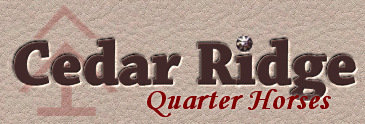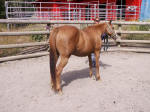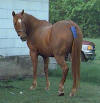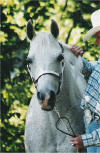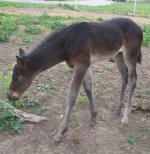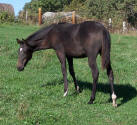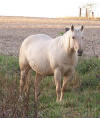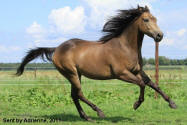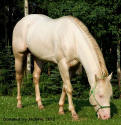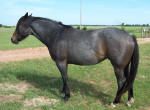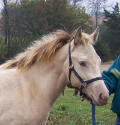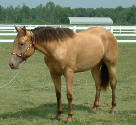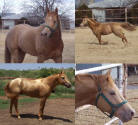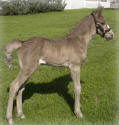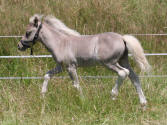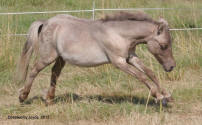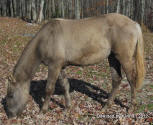

Quarter Horse Colors
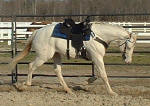
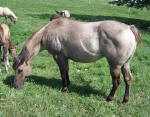


|
The Quarter Horse breed has listed 17 acceptable colors for registration of foals (as of 2006). More colors exist that aren't listed, and if you have such a foal, you should register it according to the closest genetic color option that fits what you feel the foal will be at maturity. For example, a white horse with blue eyes that is "aa" for Agouti is really a double-diluted black. But it can be registered as a Perlino, because the correct option for a double-cream-diluted black is not offered by AQHA.
In addition, champagne and silver dapple genes are present in some QH's, but their colors are not options offered on the registration application. Combinations of multiple modifying genes also exist, and AQHA can help you determine the best color to register your foal if you are uncertain how it should be listed. We have a palomino mare that AQHA registered as a red dun. When questioned, they said it was because they knew she had dun factor due to her sire being a 100% color producer. Although she looks like a white-maned palomino with very faint gold striping, they required that she be registered as a red dun. They have rules they must follow, so inquire if you have a question.
2006 AQHA Registrations By Color
Courtesy of Deb Black at AQHA and
www.prettyquarterhorses.net
Percentages added by Cedar Ridge Quarter
Horses
|
Color of Horse |
Number of Horses Registered |
Percent of Registrations |
|
Bay |
30,862 |
18.69% |
|
Bay Roan |
3,864 |
2.34% |
|
Black |
5,844 |
3.54% |
|
Blue Roan |
3,747 |
2.27% |
|
Brown |
7,660 |
4.64% |
|
Buckskin |
8,811 |
5.34% |
|
Chestnut |
13,256 |
8.03% |
|
Cremello |
741 |
0.45% |
|
Dun |
5,945 |
3.60% |
|
Grey |
11,659 |
7.06% |
|
Grulla |
1,693 |
1.03% |
|
Palomino |
13,022 |
7.89% |
|
Perlino |
234 |
0.14% |
|
Red Dun |
4,855 |
2.94% |
|
Red Roan |
5,852 |
3.54% |
|
Sorrel |
46,976 |
28.45% |
|
TOTAL |
165,114 |
|
The table below shows horses that meet the required genetics for each color. Not all horses pictured are Quarter Horses, but the color genetics are the topic here, not breeds. :-)
The colors listed (as of 2006) are:
Color descriptions above composed with consideration to AQHA color definitions.
See our Combinations page for horses with multiple genes that affect their color.
Other Acceptable Color Dilutions
Although AQHA does not list specific registration options for certain genes, there are some color modifiers that are acceptable to AQHA. These include (but might not be limited to) the Champagne gene and the Silver Dapple Gene.
ChampagneFoals might be registered as buckskins, palominos, and grullos even though they are genetically not the same. |
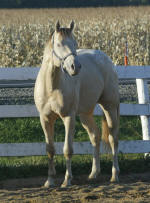
|
Silver DappleFoals would be registered as bay and chestnut in most cases, and a few might erroneously make it in as palominos. Learn more here. Only expressed on horses carrying a non-red gene or two non-red genes (EE or Ee) . Mane/tail flaxen or mixed. |
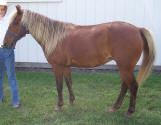

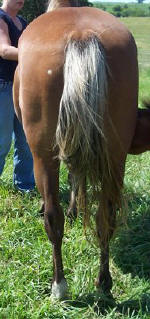
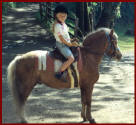 Bay silver ponies (above)
|
Photo Ownership Notice:
All of the photos on this page are the property of Cedar Ridge QH's or were
sent to us with permission.
If someone has sent a photo to us for use on our pages that belongs to you,
and if they did not have
permission to do so,
please let us know.
If you are interested in contributing a photo, we thank you! But please do not
alter the photo or place your contact
information on it. Our educational pages are for just that...education. Not
advertisements. Thanks!
|
How To Donate Your Educational Photo:
-
If you are wondering what color your foal is, click here. We are having a lot of people send us pictures for this page where it is obvious that the foal owners don't know what color their foal is. Please, only send us photos for this page if you know your foal's color. If you don't know what color your foal is, click here.
-
This is an educational page, and photos should show a safe environment and healthy horses. I don't even know how to respond when I receive photos of wormy, skinny horses in pastures littered with abandoned cars, farm equipment, wire fences laying on the ground, and falling-down buildings. I simply can't put photos like that on an educational page like this, where people come to learn.
-
Please note that this is not intended to be a free opportunity for you to advertise your breeding operation, and instead is an educational page. We will not use photos with watermarks/writing on them. There are many free advertising sites on the Internet at which you can advertise your farm/ranch/horses. Also, only send photos of foals you own. This way, there won't be copyright problems.

Feel free to click the "Send Your Photo" logo
at the left to send a good photo or two to us for inclusion on our
color pages.
Photo Ownership Notice:
All of the photos on this page are the property of Cedar Ridge QH's or were
sent to us with permission.
If someone has sent a photo to us for use on our pages that belongs to you,
and if they did not have
permission to do so,
please let us know.
If you are interested in contributing a photo, we thank you! But please do not
alter the photo or place your contact
information on it. Our educational pages are for just that...education. Not
advertisements. Thanks!
This page last updated
05/28/21
If you notice this date being 2 years or older, please let
us know that we need to check out this page!
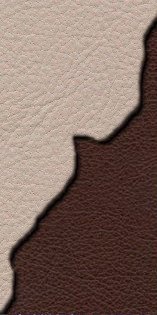
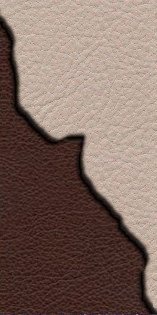
Home Horses For Sale Stallions Mares Foals Blog Color Genetics Riding Horses Site Map Contact Us

Toni Perdew
Bedford, Iowa
toni@grullablue.com
712-370-0851 cell, before 9 p.m. CST
![]()
www.facebook.com/CedarRidgeQuarterHorses
Web design by
CR
Equine Sites.
All rights reserved. Graphics are watermarked for copyright protection.
Terms of Use
